AGENDA
LA CENTRAL DEL CIRC
TRAINING
CREATIVITY AND RESEARCH
The objective of the Transits residency program is to offer support to the companies that are in need of a physical space and support to carry out their artistic projects (research, creation, rehearsals, etc.), encouraging artists to take a more active approach to research and challenge their work.
In order to meet the needs of the stage in which the creative process of an idea or project finds itself, and enable true progression, we’re proposing various residency formats, accessible to artists and companies following a public call held in November.
However, the format and conditions of the residencies evolve each year, in order to maintain their relevance and be up to date with contemporary circus reality.
Here you can read the rules and requirements of the last public call.












Artists and companies in residence


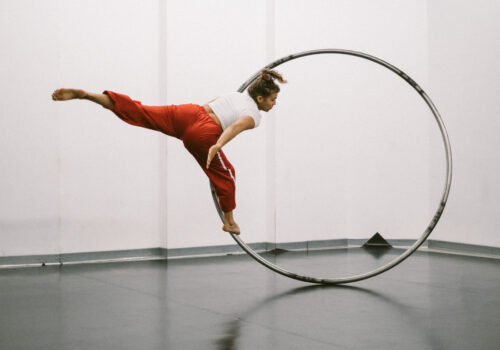


Josefina Colli was born in Badia Blanca, the province of Buenos Aires, Argentina, in 1990. Influenced by a family of plastic artists, she decides to study visual arts teaching in the city, but at the same time she discovers the circus, exploring different disciplines until she encounters the Cyr wheel.
In Badia Blanca, she establishes the “L’enlairament” company, which will receive the support of the Fons Municipal d’Arts on various occasions, including for the “Entre nos” Cyr wheel production, in 2018.
Self-taught for years, she decides to grow artistically and travels to Europe where she attends the courses of the FLIC circus school in Turin, Italy. She continues her training and, seeking to expand her corporeal expression, she attends the Area Dansa Barcelona contemporary dance school, in Barcelona, where she now resides.
Following learning, research and development of both disciplines, she asks herself: How to create and develop a personal language where both disciplines can cohabit and articulate without evolving into a hierarchy?
Poética salvaje
“Poética salvaje” questions and investigates the relationship that exists, and still doesn’t, between the motion delivered through dance and the Cyr wheel, analyzing each of them separately, in order to bring them to the question-action: how can they be interwoven to find the retronourishing instant, flux and coexistence of both techniques, leaving aside the hierarchization and betting on democratization?
A constant dialogue stemming from a visceral place that has its origins in unanswered questions, poetic writings and antonyms, which could deserve organizing or not, but maintain the body-object in constant feedback, creating a free place without massacres where the body-object presents itself as a guarantee of the most concrete, of a movement truth.
A research work that receives its inspiration and nourishes from different dance writers and philosophers, as well as circus-dancers who talk about the body, the game and instant composition.
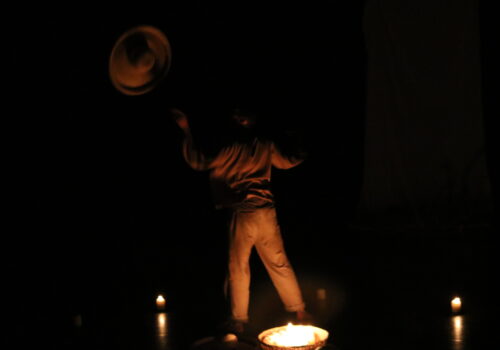


Soa Payet, stage author, works with memory, the one that will be and the one that will become following our present actions. It’s about rediscovering the stories that arise from the circus imaginary, in a more extensive sense, where dance, text and circus object mix.
He grew up between the Paris region, the island of Reunión, Columbia and finally Ecuador. He trained as a circus artist at the Amiens, Montpellier, Brussels and Toulouse circus schools.
He was a dance, clown, Butoh and theater apprentice. All these fields led him to focus his work on his own roots, to understand that which traverses generations and demands listening to.
Zoé Debary, in theater, carried out an academic research on circus gestures and words. From her trapeze-dance, she came down to the stage floor to take a step into the choreography of bodies through GAGA (GAGA MOUVEMENT) dance and the actor’s opening thanks to the Chekov training, in Brussels. Following her experience, she accompanies circus artists in their creations, «Circus remix» from Tercer Circ (2017-2018), «No puc morir» from Cie La Gesti (2019-2020), «PAPY» from Lucha Emilia (2020-2022).
Her research resonates in her works and her works resonate in her research. How do we embody (drama)circuses?
La memòria de la Pepa
Our project came to life between the mountains of Medellín and the heights of Reunión. We’re looking to formulate our internal screams. Screams of uprooting, screams hidden in crammed throats, silent screams that are heard from the bottom of the earth, screams of our ancestors and descendants.
“La memòria de la Pepa” is a circus story, the story of Pipo, a globetrotter. Remember, remember, make it materialize, bring it to light, the terrific spirit of the colonial plunderer and the depth of the jungle. Juggling with his “toquilla” straw hats, his candles, his dangling fabrics, he structures the space and his time. Pipo transforms and creates his own rituals, he dances his loss, with love.
We don’t choose to represent any culture in particular. We choose to invent a story inspired by the memory of our elders and its role in today’s questions which demands new formulations. We gather in the history of our memories to find fragments of what has been lost and what has to be reinvented.



From a young age she’s been interested in stage arts, exploring dance and theater, to later discover the circus through the Center for Aerial Arts, in Santiago de Chile. Once she decided to make the circus her professional life, she trains at FLIC Scuola di Circ (2015-2017) and L’ecole de Cirque in Lyon (2018-2020), specializing in hand to hand.
She became part of the Michele & Francisca company, being co-author of the SIGNES performance, which toured in different formats between 2020 and 2022.
Currently she’s part of the COLLETTIVO COLLETTIVOM, with the Mariage performance (premieres in 2024), and the Q||MƎRA COLLECTIVE within REQUIEM -research for a non-organic performance.
Interested in music as a self-taught artist, she conducts audio research and musical creation using voice and a loop station. Also, she is part of the semi-professional, feminist choir “L’ebranleuse”.
La primera y la última
Made it to the end and now I’m at the beginning again.
“La primera y la última” is a thrilling, agitated and impatient creative process designed to give way to a mutant and transformative artistic experience.
Driven by the desire to rediscover myself on stage as a legitimate and artistically expressive body, I welcome this creation within the “essential research” program, a time to lose myself inside a space for experimenting and tearing.
Breaking down and rebuilding the languages I had previously used, to dive into a liquid and unstable means of expression where delimitations between each language are blurred.
Music, voice, movement, margins, political body, dizzy, new imaginary: a part of the threads that will interweave during the search.
Could be that all this is a good description of what I’m trying to do, considering that possibly, it will be the complete opposite.
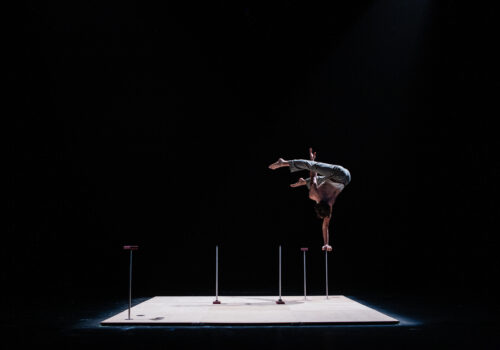


Born May 2nd 1998 in Badajoz, Extremadura region of Spain, where there are many oak trees. He was less than two years old when he was dancing to Sonia y Selena in the living room of his house, imitating each choreography from his sister’s graduation VHS tape. When he was eight years old, he wrote a poem to Virgin Mary and the rest is history.
He did his professional training at Carampa, between 20016 and 2018, and during the next course he became a part of various Freestanding Courses at DOCH, School of Dance and Circus (Stockholm), of different specialties of his discipline, hand balance acts and a course on the artistic development within circus disciplines.
In June 2019 he takes the tests and is admitted at the Brussels Higher School for Circus Arts, and three years later he graduates, and has longer hair, and he likes rain less, and he likes coffee more, and writing more, and the circus more, I suppose. He also receives his Master’s degree in Poetry from the Madrid Writer’s School and is part of the Simul Solus Collective. El patio is his first solo project as a creator/artist.
El patio
‘El patio’ is an interdisciplinary research project that plays the part of experimenting with intimacy, desire and the power of language through the stage fusion of poetry and circus, using acro-dance, hand balance acts, live writing, sound works and voice as means and channels to express.
There’s a factual meeting point between the two disciplines, from which the skeleton of the project is born: the way in which they use pure technique as a creativity channel and form as the final object. Building a space within a space, “El patio” plays with the limits between the truly intimate and the completely public, as when you try to disclose or share something intimate, its very intimate quality vanishes and it acquires a new dimension for a few seconds.
“Intimacy is a fish flopping between two oily hands and I’m losing oil, a lot of oil”.



After studying at the FLIC circus school in Turin, Italy, Andrea Speranza continued his juggling studies at the circus school in Lyon. After, he became interested in studying magic in all its forms and developed his potential as an illusionist.
He takes part, as an artist, in creations like Censura, directed by J.M. Guy, Roberto Magro and Johnny Torres in 2019, or Impromptu, from the Catalan company Circ Teatre Modern, in 2014.
Worked as creative support and illusion effects adviser with La Frontera company and for Alice Rende’s Passages performance. He also works for various businesses as a special effects consultant. In 2021 and 2022 he was part of the Support Group for the Horizons de Cirque cross-border project, and also participated in the third module of the European project Digital Lead held in Terrassa, Catalonia, and in the Antípodes cross-border project, a La Grainerie de Toulouse (France) and Pistacatro (Spain) joint venture.
Currently, he’s attending the Project Training courses at ÉSACTO Lido, in Toulouse.
Cose a caso – trucos asì o cosas detràs
‘Cose a caso’ is a creation project of physical experiments and close-up magic for intimate spaces.
‘Cose a caso’ is a solo who doesn’t pretend to talk about solitude, but who on the contrary tries to weave relationships with the audience and between the audience itself.
Experiments and illusions presented here are only a means to create relationships and connections.
It is a solo who does not want to be such and who tries to establish an active conviviality of other times between the illusionist and the audience.
Starting in a joyful and conversational way, the atmosphere transforms to veer towards different aesthetics. Manipulation of ephemeral materials, such as ashes, shadows, mirrors and light.
The magician plays with images to perform illusions: reality or realities? Magic comes out from the ensemble, it’s not the power of the magician.
Asking over the frontiers of not knowing when and how a trick starts or ends, if there’s a mistake or if magic was made from an actual and volunteering decision. Is this an illusion?
Firma foto: Thomas M.B.
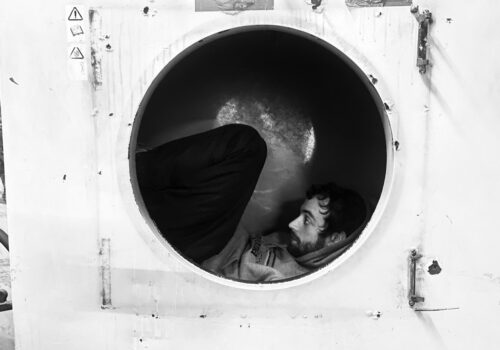


Born in Reus, he trained at the Rogelio Rivel circus school in Barcelona (2010-2012), the Pekin International Art School and ÉSACTO Lido in Toulouse (2014-2016)
He specialized in hand balance acts, torsion, dance and theater. Co-creator of the Random company. CircusNext 2019 prize winner.
He performed in different European locations, at the Circ d’Hivern de l’Ateneu Popular 9Barris and Mercat dels Flors (Barcelona), the Theatre de la Cité International (Paris), CircoBalkana (Croatia), La Grainerie (Toulouse), Halles de Scharbeck (Brussels), Mesopotàmia Circus (a festival in Türkiye). He danced with artists from Krump, Butoh, African dance, raves and elite level Bachata.
‘Candy’
“I encountered certain difficulties when going back to regain possession of myself. It’s a strange experience. Perceiving the legs as separate objects, estranged from the mind, to which they’re connected almost by chance. Imagine yourself with skepticism, as a pile of flailing members… and one needs these members, needs them desperately, but even so, sometimes, they seem very strange, very strange. The legs, above all.”
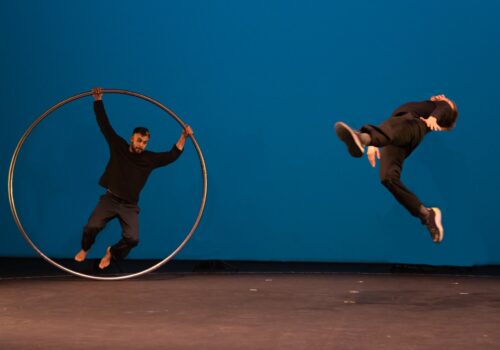


Felipe Nardiello
His artistic path begins with the separation from the world of psychology (the profession he was dedicated to) and opening up to the circus. He studied at the FLIC circus school in Italy, where he specialized in Cyr wheel.
Ginés Belchí Gabarrón
He begins his professional studies at the Rogelio Rivel circus school in Barcelona, following which, he studies at the ÉSACTO Lido, in Toulouse, where he specializes in acro-dance.
At the end of his studies, he creates and acts in the El costat fosc de les flors performance, takes part in the Circ d’Hivern SOPA de l’Ateneu Popular de Nou Barris and in the latest creation of the Primavez (France) collective –Intudewail.
Que me tiren al mar
‘Que me tiren al mar’ infiltrates an intimate, relational dimension, in an emotional space. It’s a voyage trying to connect with the general theme of problems, through physical emotion.
Quin és el teu problema?
It’s a physical story talking about being human from a problematic capacity, a fragility capacity, a capacity to question how the modern subject relates to its own life.
Quina és la teva solució?
In an abstract philosophical universe, the bodies and the Cyr wheel articulate the discourse. Their words are built for the acrobatic movement of two bodies, the emotional relation between these two and a Cyr wheel, which urges cyclical and circular situations, which can become either problems or solutions.



Cavitat f.
Each body is a synthesis of his own history. Memory can be explicit when we can reasonably explain or describe a concrete experience, or implicit when the body reacts to experiences that cannot be processed by the mind. “Cavitat f.” is an artistic project that investigates the materialization of memory in the body, or in other words; embodied memories: everything that is recorded on the body as a movement, gesture, sound or posture in memory (mostly unconscious) of a concrete experience. The idea is to facilitate a work that puts the body in relation to the codification of these memories, to understand the forms and their learning processes, to see which ones and why they have been forgotten and if it is necessary to make them visible and perhaps resignify them. The project wants to observe how the context affects all this and also the relationship between two or more bodies and think how to generate collective body memories.
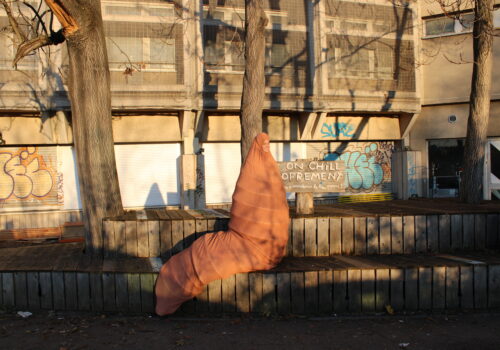


Abby Neuberger and Luca Bernini met at the FLIC circus school in Turin in 2012, where American gymnast and Italian jonglor began working together hand-in-hand and physical theatre, to create a body vocabulary typical of their duo. Together they entered Fratellini Academy in 2014 where they continued to perfect their aerobatic technique and developed their research around a playful and absurd imaginary (Willy Axton 2016; Morning 2017). Since its premiere in 2017, they create their first show, Compost.
Abby and Luca believe that the performance is an act of living in the present, in the space they are in, as well as a discovery of surprising things, the unexpected, with the audience. With the Keep Company, which they create in 2019, they want to question our collective relationship on earth and defend the performing arts as legitimate means of opening discussions about the environment. And through the show, they continue to look for what human beings can mean, through humour and laughter.
‘Underfoot’
With ‘Underfoot’, we’ll deal with the subject of nature through the angle of decomposition, of what happens after death, of the transformation of matter into another way of life, or into another living being. The team will be interested in the decomponent actors (or transformers): worms, protocharion, bacteria; for chemical reactions that are the basis of substance transformations; for reactions between atoms that create new substances without loss or addition of components. And through their language, mixing physical theater and hand-to-hand techniques, they will try to represent these reactions and relationships.
In a longer range, echoing its first creation ‘Compost’, Abby Neuberger and Luca Bernini attempt to follow the history of life cycles: evolutions and changes of geological times, and the trails left by changes of species after thousands of years of life on Earth.
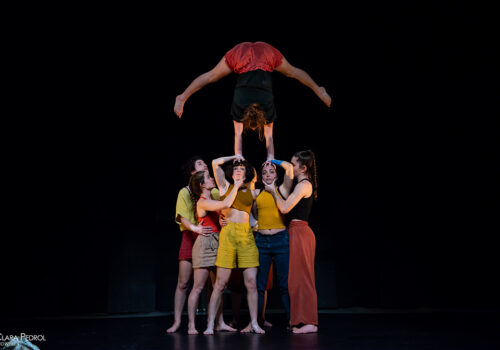


Kolektivo Konika was born out of the necessity to gather into a community to create, evolve as artists and examine the discipline of acrobatic balance between women. Its members are Candela, Elisa, Greta, Hannah, Michela and Shakti. In March 2021 they premiered the La punta del meu nas performance. While touring with this performance, they realize they have so many ideas that only one production doesn’t suffice and the only thing left is to dive head-first into a new creation. That’s when they think about collaborating with Ino Kollectiv.
Ino Kollektiv
A collective created by Alba, Chloe, Eva Luna, Lav, Noémie, Raphaëlle and Rebecca, six nationalities, five different languages and each of the members with a personal universe boasting a strong identity. All this diversity presents to them a world of beautiful complexity, which makes them want to share. In 2021 the collective opens up to new collabs, like a collective creation about improv and circus, together with Kolectivo Konika.
IMPROPORTES
There will be circus and improv, sixteen women on stage in a mix of hand to hand, music and song, in a Varieté Cabaret setting.
Everything is created on the spot: each performance is unique, different and magic. A show which the audience can repeat without repeating.
We feel for playing. A meeting point will be the hand to hand, a discipline that compels us to gather and secretly recreate ourselves into a pattern that, in each interaction, singularizes our particularities into a fleeting encounter, again.
Thirteen artists, one presenter and two musicians. A unique and unrepeatable circus experience: nothing can go wrong because it never happened.
Picture: Clara Pedrol
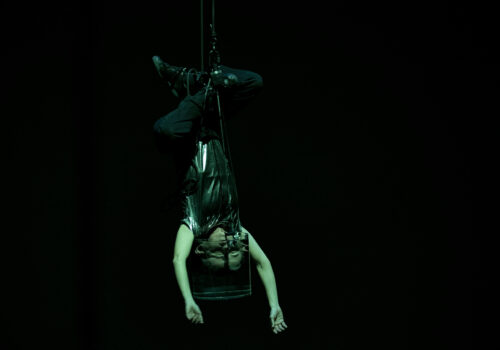


Elena Zanzu is a performer, an investigator, a playwright. Her theoretical and practical interests gravitate around gender, disability, ethics, cures and artistic research methodologies.
Licensed in pedagogy at the National School of Circus in Montreal, with a Philosophy Master from the University of Bologna, she studied circus drama at the CNAC National Center for Circus Arts in France.
Between 2020 and 2022, she was part of The Circus Dialogues (continued), a project investigating circus practice and theory, at the KASK University, in Ghent. She teaches circus and gender at UAB. She’s a member of the CCCirque investigators collective, and curates events about research, artistic practices, drama and gender.
Her solo act “EZ”, which premiered at Mercat de les Flors in May 2022, and was awarded by the European platform Circusnext, addresses power dynamics and consent negotiation.
(HYP)NO Research (títol provisional)
Elena Zanzu begins a new research process, around trance induction techniques, hypnosis, magic, illusionism, fakirism and other extreme practices. Putting care, relationships, roles and power exchanges at the center.
Picture: Mila Ercoli
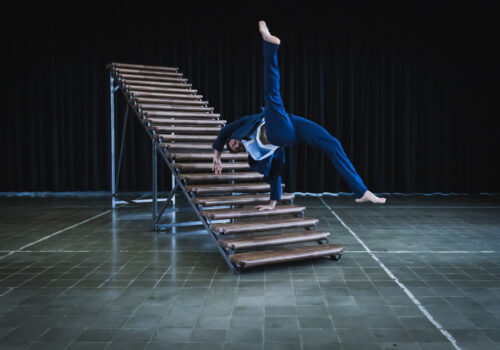


Grandchild of a grandmother who was going to become an actress when the Civil war started, son of a father who was going to become a clown until he discovered journalism, Manel Rosés Moretó, comes from a family of “semi-artists”.
Restless by nature, he finds in circus the means to be in motion forever. This takes him on the acrobatic path of training at the Rogelio Rivel circus school and at the DOCH Circus and Dance University, in Stockholm. During the first part of his professional career, he works with the Korean plank quartet -Balagans- at different circuses and cabarets, like Cirque du Soleil or Circus Roncalli. A severe injury forces him to switch to office work and during his recovery, he decides to train in other fields of stage arts. He takes a drama course at Beckett and once fully recovered, he continues training in movement, theater and drama. In the second stage of his career, he takes part in performances and acts like inTarsi, from the EIA company, or Desdèmona by Alba Sarraute. In 2016, together with Nilas Kronlid, he develops his first performance –Gregaris.
Current project: ‘Alias Mariano’
‘Alias Mariano’ talks about the fact of staying, about other possible lives and about past lives. About desires, infinities, and about our limited existence.
In the middle of the hall, a ladder that goes nowhere represents the constant temptation to escape, for the man who resides. Underneath the ladder, the objects that root him to this space and that he has to detach from in order to leave. How to leave this cul-de-sac? How to inhabit a place you already know?
While trying to answer these questions, he’ll have to learn how to move with agility and precision in this space, each time more diminished, under the ladder. He’ll have to extend the twenty-two-step climb to exhaustion. And he’ll have to repeat, in a loop, the movements, each time more complex. Challenges of a man who’s seeking to redefine himself, questioning that which his life has sculpted thus far; his office. An office of which he talks about through a mix of irony, melancholy, disappointments and tenderness.
Picture: Marta Garcia Cardellach



Ino
Seven women, do not have much weight in this world.
So we thought: “What if.. we pile each other up?” INO is us, dressed in various layers of social conventions, just like everyone else. Layers that bother us and that don’t allow us to move freely.
We grab one another by our clothes, we pull each other, we help each other to remove the layers that cover us. We realize that it’s heavier to carry the weight of social expectations than that of our own bodies.
We hold onto one another, we cling to each other, we support each other. Simply it is what we want to do, together.
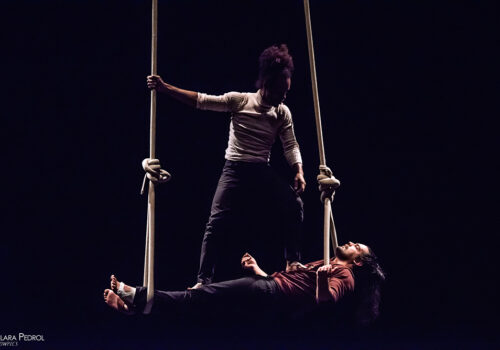


La companyia neix en 2018 a la ciutat de Rio de Janeiro. En aquest moment, Thiago Souza i Roberto Willcock són estudiants de l’Escola Nacional de Circ do Brasil. Tots dos s’adonen que comparteixen la passió per la tècnica de la corda llisa però, al mateix temps, un sentiment d’insatisfacció amb l’aparell.
Amb la idea de buscar altres possibilitats a més de la clàssica tècnica de corda, els artistes van iniciar la seva recerca. Les cerques pretenien plasmar les següents preguntes: com trencar amb la idea de verticalitat/altura en la corda llisa? Com fer nusos, no sols de forma vertical? El 2019 els artistes es muden a Itàlia per estudiar a la FLIC i treballen amb Flavio D’Andrea, Roberto Magro, Florent Bergal i Eva Ordoñez. Aíxí, treballen actualment en la que és la seva primera creació.
Cá Entre Nós
“Quan ens acomiadem amb la promesa de no estar lluny per més de 10 dies, vaig saber que no seríem capaços de complir aquesta promesa… Encara tinc espai per a tu, aquest tu en el qual t’has transformat lluny de mi… ”
La revelació de la intimitat, o millor dit, de la súper intimitat. Fora mida, però que succeeix aquí i ara, entre nosaltres. “Cá Entre Nós” exterioritza l’ambivalència entre poder i dependència, riscos i confiança en les relacions, que sorgeixen en un temps i un espai coincidents. “Cá Entre Nós” és una expressió brasilera que podríem traduir com “entre nosaltres”. Però no per casualitat, en portuguès, la paraula “nós” (nosaltres) també es pot traduir com a “nus”. Al mateix temps, “cá” (aquí) reforça la idea d’un aquí i un ara. Així, “Cá Entre Nós” és una narrativa creada a partir de la relació entre els cossos presents en escena i es desenvolupa a través, sobre i en funció de l’elaboració de nusos.
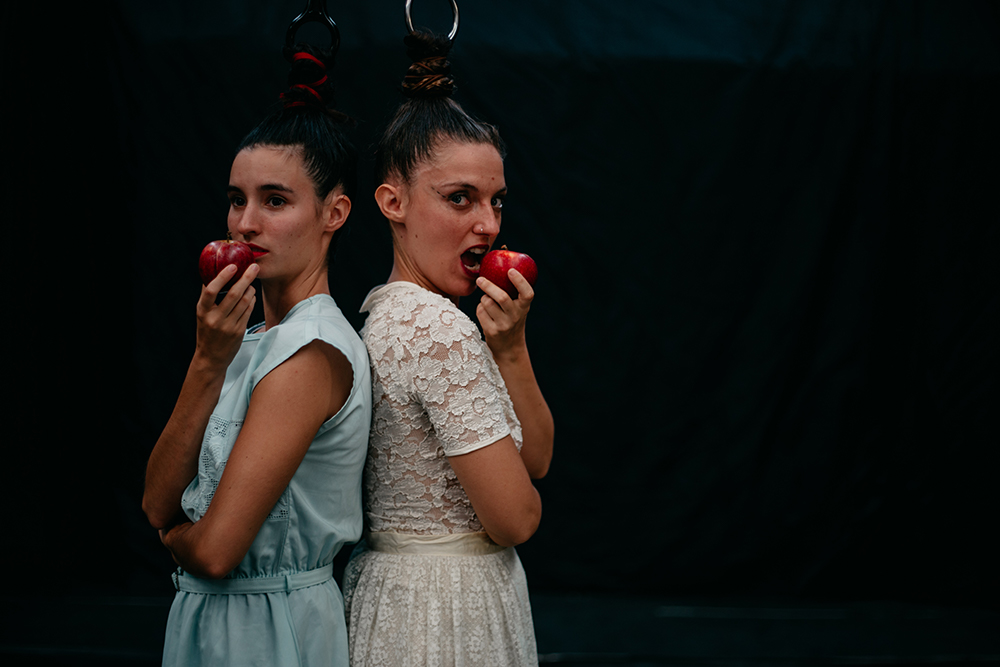


Elles
A multidisciplinary show. A combination of circus, movement and live music searching for a language that will define them.
They investigate identity and gender, treating them from a fresh point of view. A stage concert of electronic music where two people walk the scene in a continuous ecstasy and bewilderment, questioning their identities and their way of relating to each other. Questioning her identity as women and the clichés they are associated with. What is a woman? What is a man? What are we if we are nothing?
Out of control, they step on glass, they mix music live, they play instruments face down at several meters high, they suspend each other by the hair, they throw darts, they explode apples, they eat them and form body structures impossible to decode.
Picture: Mar Bautista
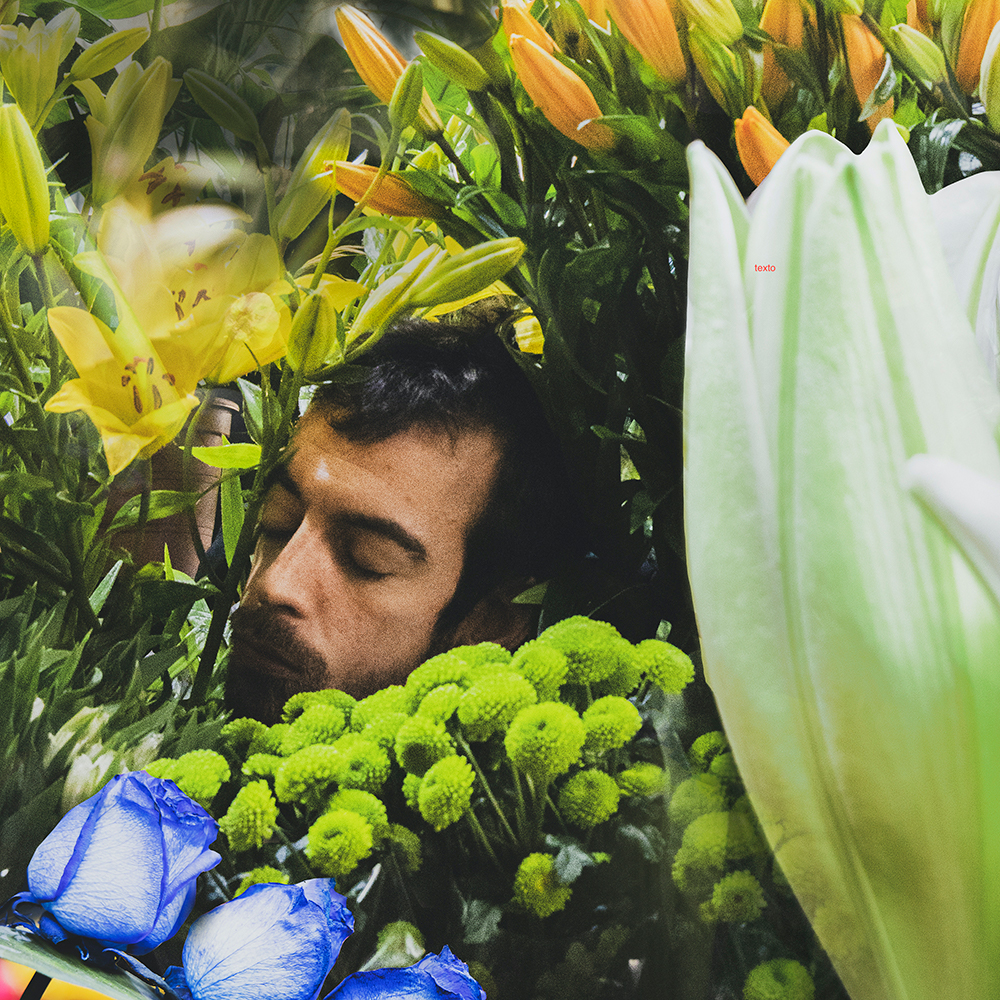


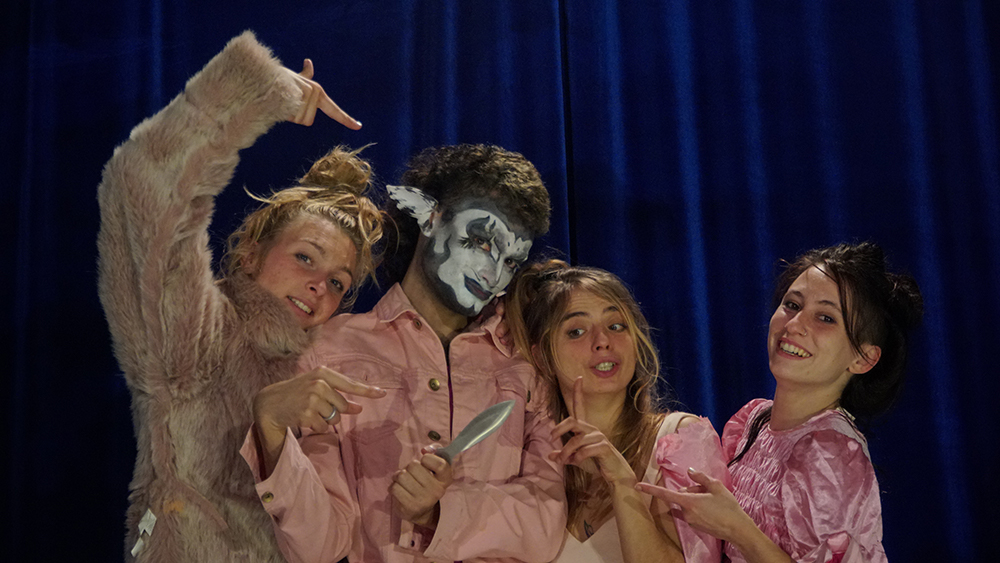


Niebieski
Four people enter a blue room, as a plane about to take off. A space of emotional management which reveals its system, adapting and offering what is necessary to modify and move freely within those aspects that society calls unworthy and secret.
They will appropriate symbols of popular culture through playing with the everyday objects that the room provides. A circuit where painfulness and dirtiness mutate into a ritual of initiation of which they were deprived. To develop a way to relate to the emblems of patriarchal binarism will lead to a collective narrative. They will put empathy into practice, to navigate all the processes of turning empowering everything that once was inappropriate.
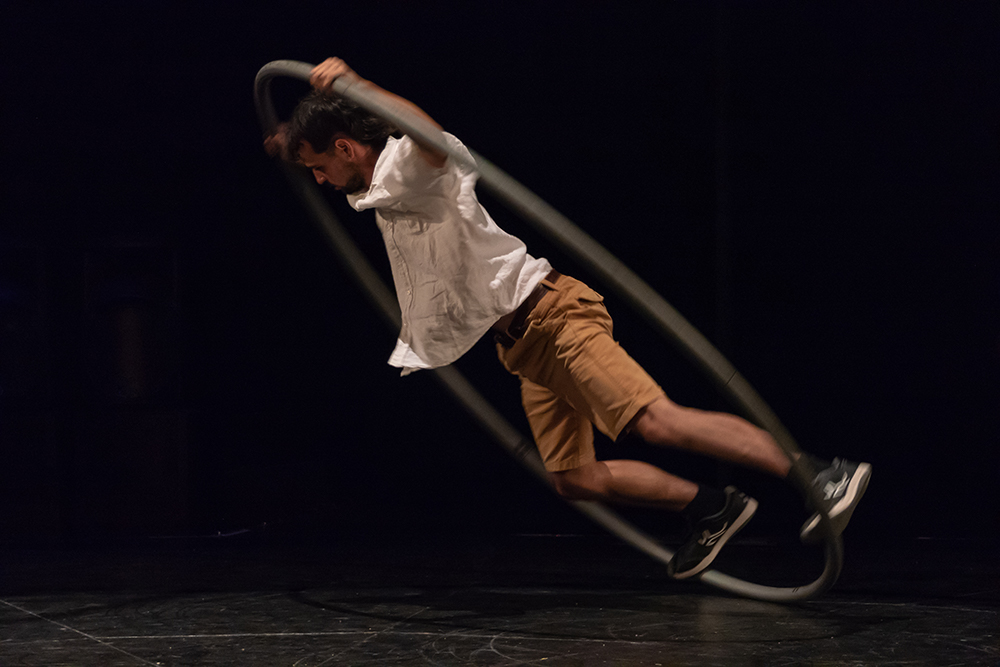


Pròxima Centauri
The scene is full of autumn leaves. A pendulum swings at ground level and removes the leaves with the air it generates. From here the staging plays between what is natural and simple and what is artificial and complex, through elements such as water, leaves, pendulum and a cyr wheel.
With the help of these elements, it explores the languages we use through science and art, seeking in creativity the common point between any scientific and artistic discipline. It takes as a reference the evolution of a star similar to the sun and is reflected in its vital phases from birth to death. Is science simply a way of understanding the art present in nature?
The piece is named after Proxima Centauri: the closest star to our solar system located about 4.2 light-years away and is part of a 3-star system, one of them very similar to our sun.
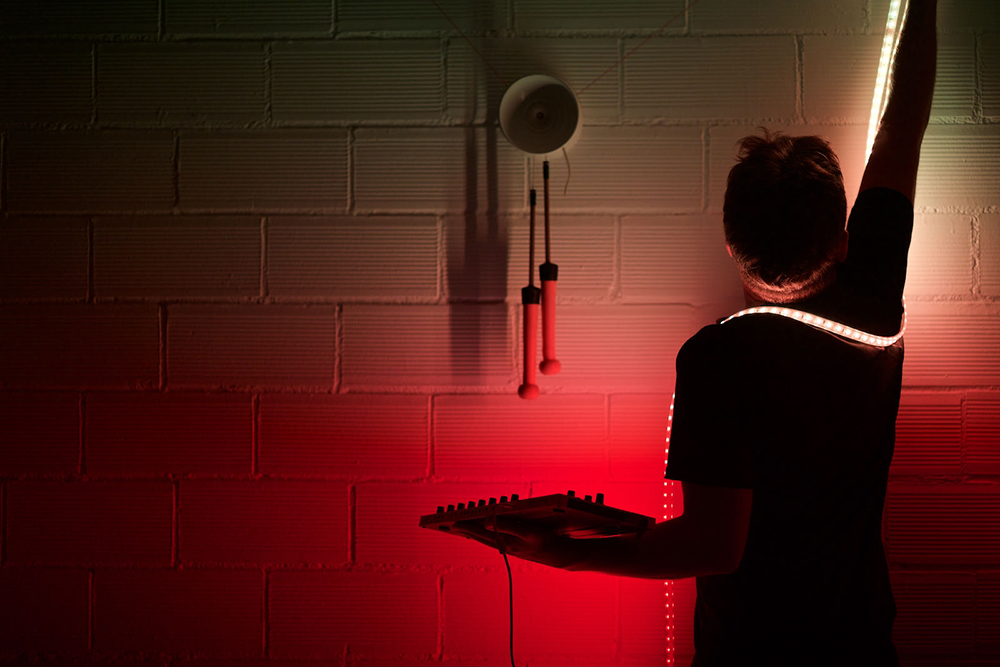


Polychromatic Void
For some time now I have been quite obsessed with ambient music and the generative systems that many sound landscapers use to reach new horizons and textures. After researching a lot about generative music, I decided to do the same with juggling, and look in the direction of a couple of subgenres that I currently call Ambient Juggling and Generative Juggling.
Ambient Juggling is an unpretentious juggling, it is an act that has as its engine the constant dissolution, it exists without having to stand out with respect to the environment. Generative juggling goes a step further, trying to understand the whole environment as a system that gives inputs and receives stimuli, and based on all these parameters it evolves towards unplanned places, but they can be bounded. Polychromatic Void is more aimed at “generative juggling”. Create a system between juggling, juggling, video, music, lighting, code and other elements, where everything is connected and in a constant dialogue.



‘A hang up’
Between newspaper, madness and anxiety, we see the agony of a circus artist who is trapped between his technique and the manipulation of his alter-ego. The artist, as a subject of performance, “believing” in freedom, has been chained to self-exploitation.
The subject of our story – where passion and obsession, conscious and unconscious are mixed – travels on this journey, unable to recognize and understand this constructed reality.
We will look at society from the exhaustion, fatigue and suffocation of overproduction, hyper-performance and hypercommunication, which blur the concept of the real.
What does this tiredness consist of? Is it really possible to accept that today’s freedom is paradoxically a new form of enshacklement? From these questions arrives the project ‘A Hang Up’, a piece of critical and contemporary character.
Image: Clara Pedrol
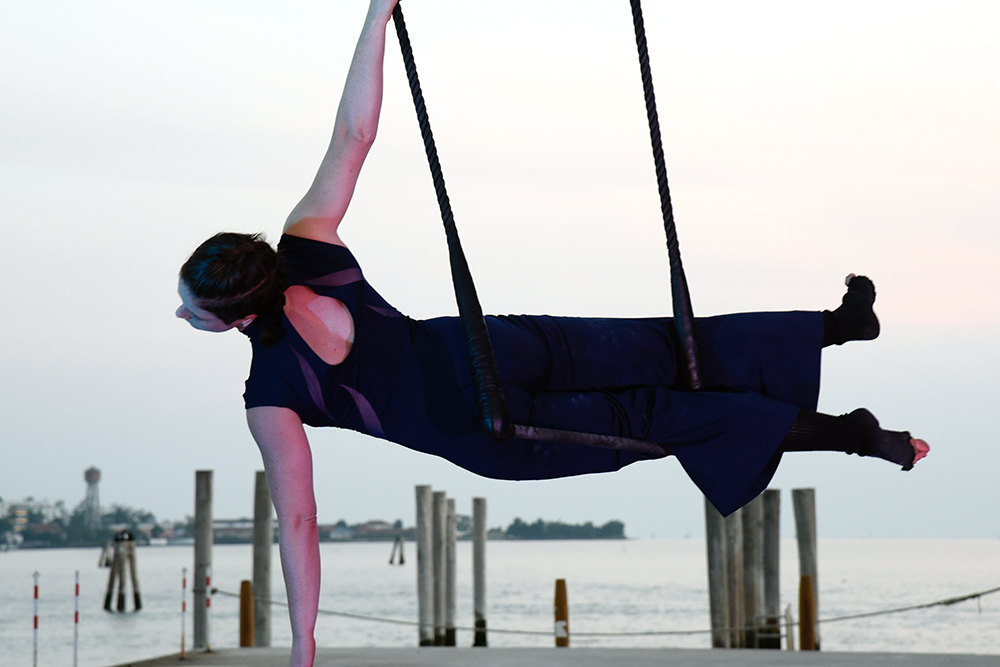


liturgia atómica
‘liturgia atómica’ is a stage play that inquires into and brings together various personal and global concerns through circus, dance and physical theater. Focusing on Butoh and Trapeze techniques, it plays with fragmented memories of a traumatic past and their manifestations in the body.
Through a soundscape that combines whispers, music and whale sounds, the show recreates a kind of ritual from all that is hidden, and opens the door to the possibility of diverse encounters with faith and enlightenment – this in the face of the existential void that is presented by multiple contemporary crises: climate change, violence, the pandemic, etc…
Crèdit: Katarina Rothfjell
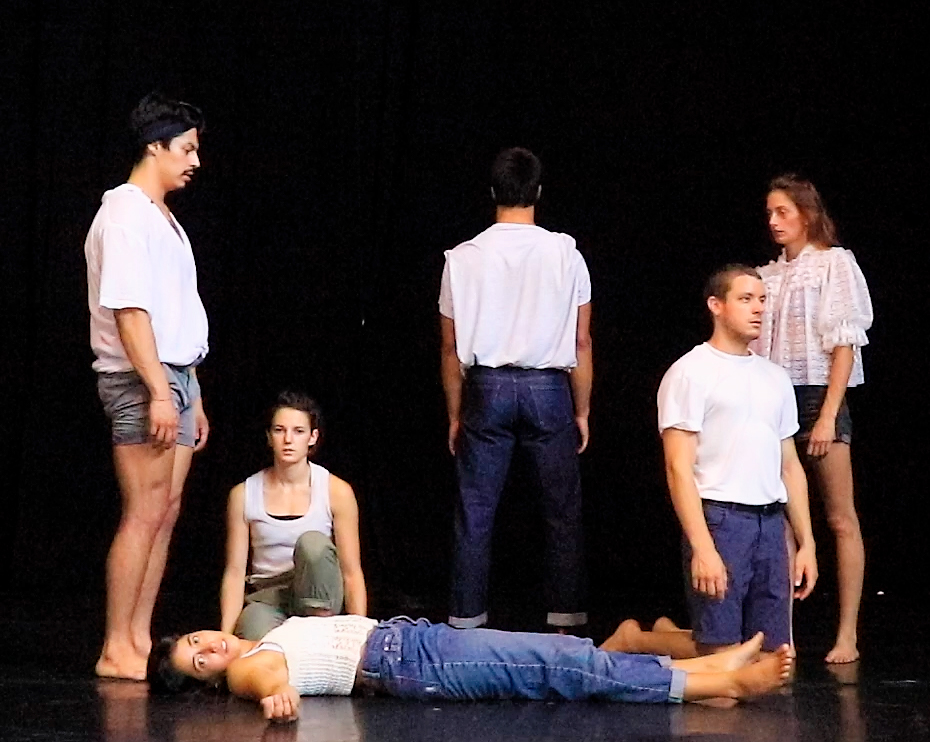


‘Mariage’
Based on the idea that all stage scripts include people, objects, and actions, Collettivo Collettivom creates a code called a “POA system”. This path of conceptual and scenic exploration leads them to a series of reflections: on the behavior of a group in relation to elected rules; on the process of appropriating a rule; on interactions between different communities that do not have the same rules; and on the search for the moment that leads us out of pre-established agreements.
The aim of the research is to observe all the reactions of adaptation, resistance and personal interpretation that occur in this process of translating theory into reality; in this context, it focuses on everything that cannot be controlled or predicted. Despite the codes and formulas: the human variable.
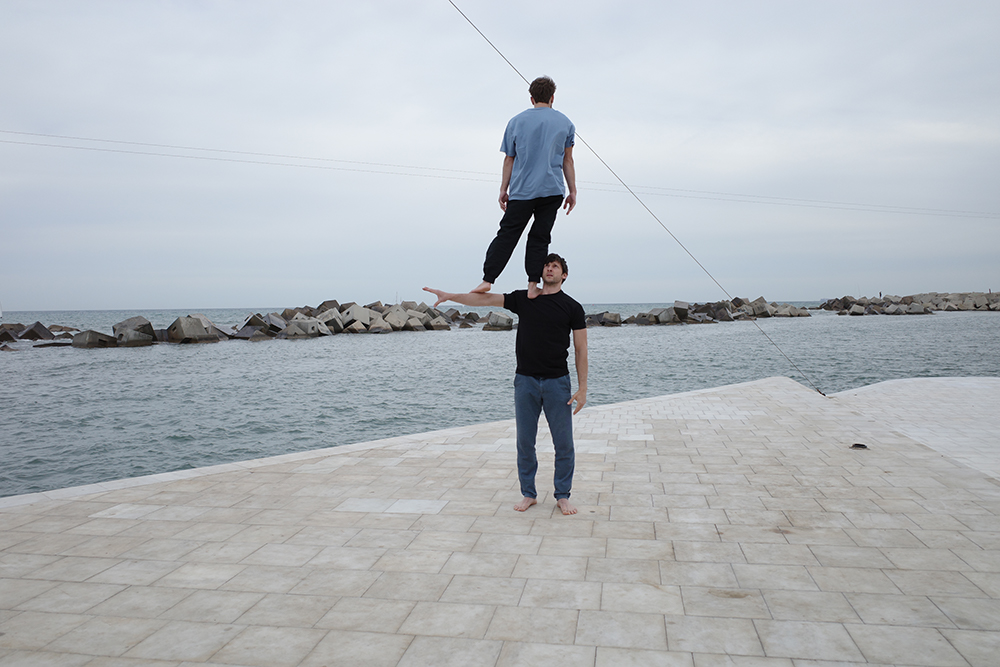


‘Apus’
The Apus apus (black falcon) is a bird that has adapted extremely well to a life lived completely in the air and can spend nine to ten months flying non-stop. That’s why this bird eats, copulates and even sleeps while flying, and only lands to nest.
Through movement, the techniques of hand to hand and handstand, Guillermo and Enrico investigate how they can stay airborne as long as possible without touching the ground. What relationship does the role of the top mounter have with the air? What about his base? How long can the base carry his colleague without him touching the ground? With these premises, the two artists aim to generate a language of the body between them that extends from but is more than mere technique, and to carry to the end the resistance of their two bodies.
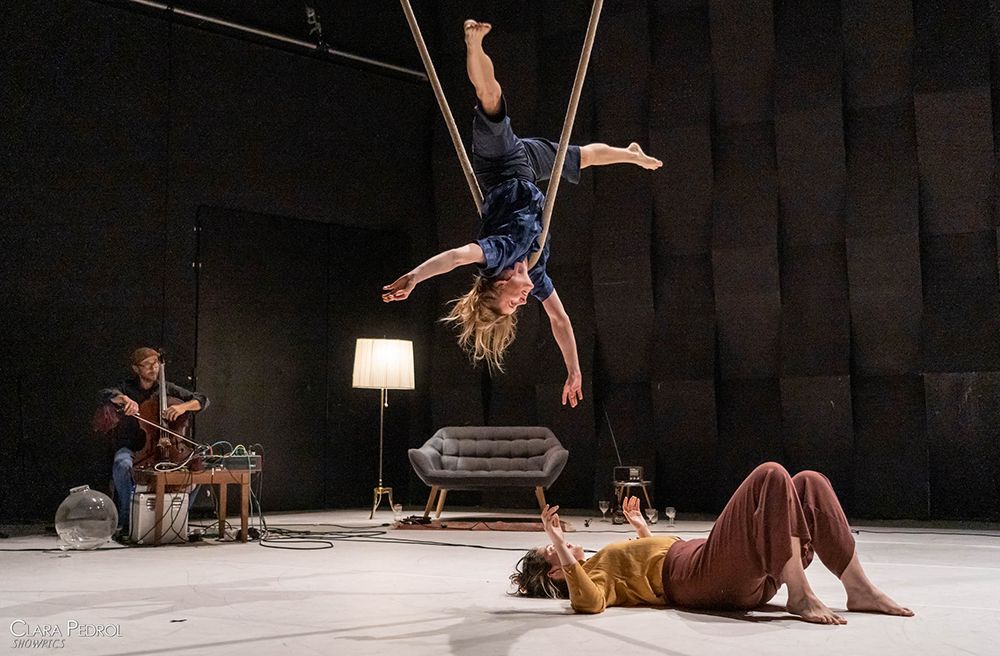


‘Kristall Bohème’
‘Kristall Bohème’ is a research and creation project and a platform for visibility and experimentation for circus language and blown-glass crafts, a trade that is disappearing.
It is a performance with a circus artist, a musician and a lyrical singer which delves into transgenerational memory, roots and footprints. It seeks a balance between what is new and what is old, claiming that the former cannot exist without the latter.
The composition of the show is based on movement and acrobatics on the U-String, fakirism, and object manipulation.
Picture: Clara Pedrol
Related news

Open registrations for the P.L.A.T on November 20 with Cia. Croma and Luis Mantilla

Resolution of the call for the Transits Residencies 2026 and the ‘Barcelona Crea Grants – Creation Factories’
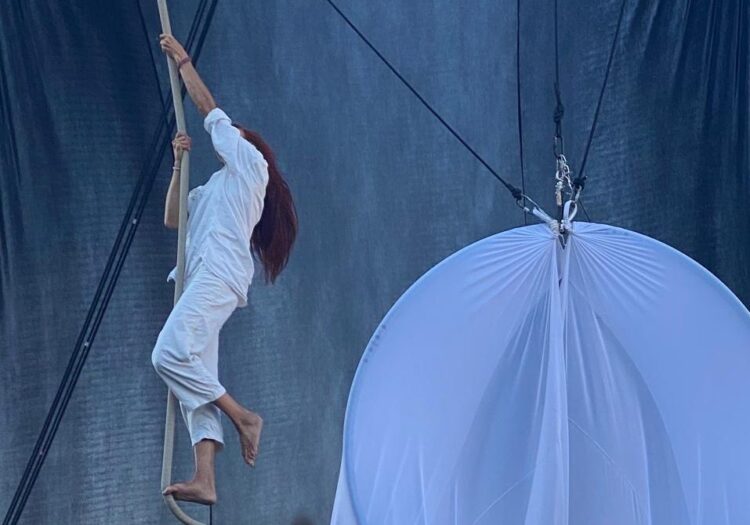
Open call to participate in CirCulem 2026/2027
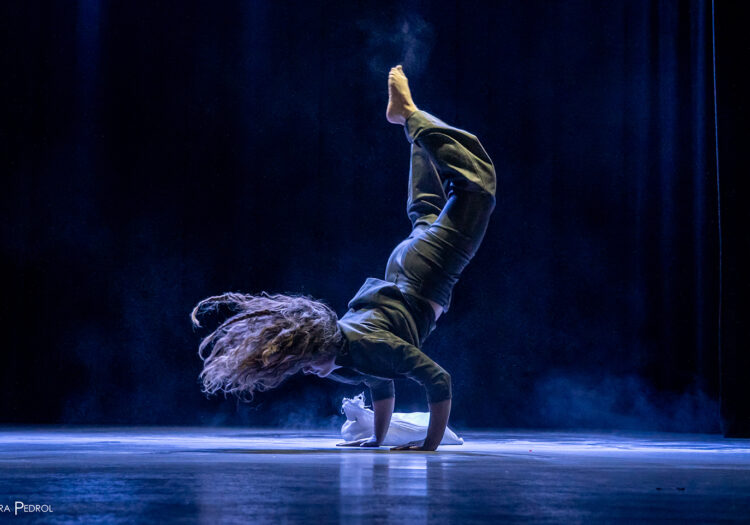
Open Call – Trànsits 2026 Residency Program, supported by the ‘Barcelona Crea Grants – Creative Factories’

Resolution of the 2025 Iberescena Program Call for Proposals

“Can We Create Without Memory?” Check out the 2025 fanzine!
Other residencies
MEDIATION







